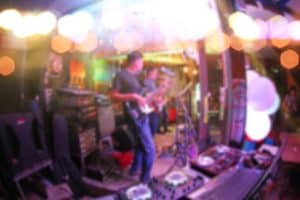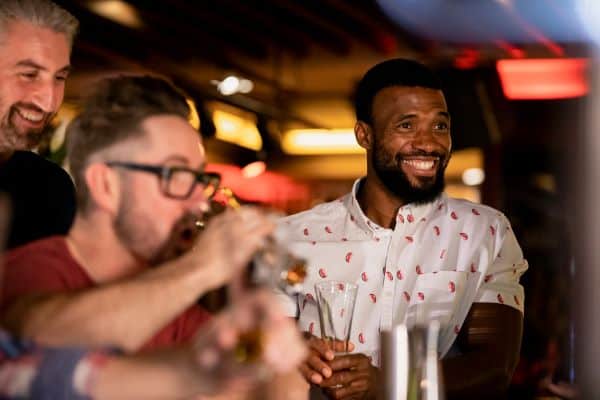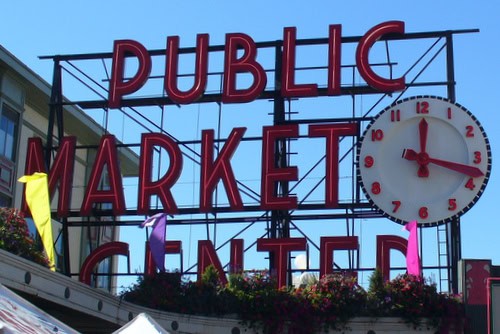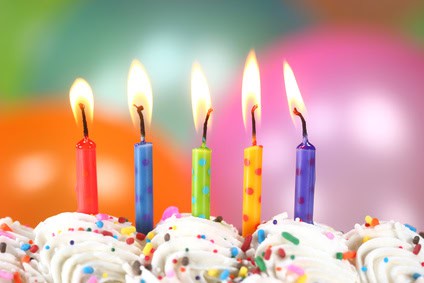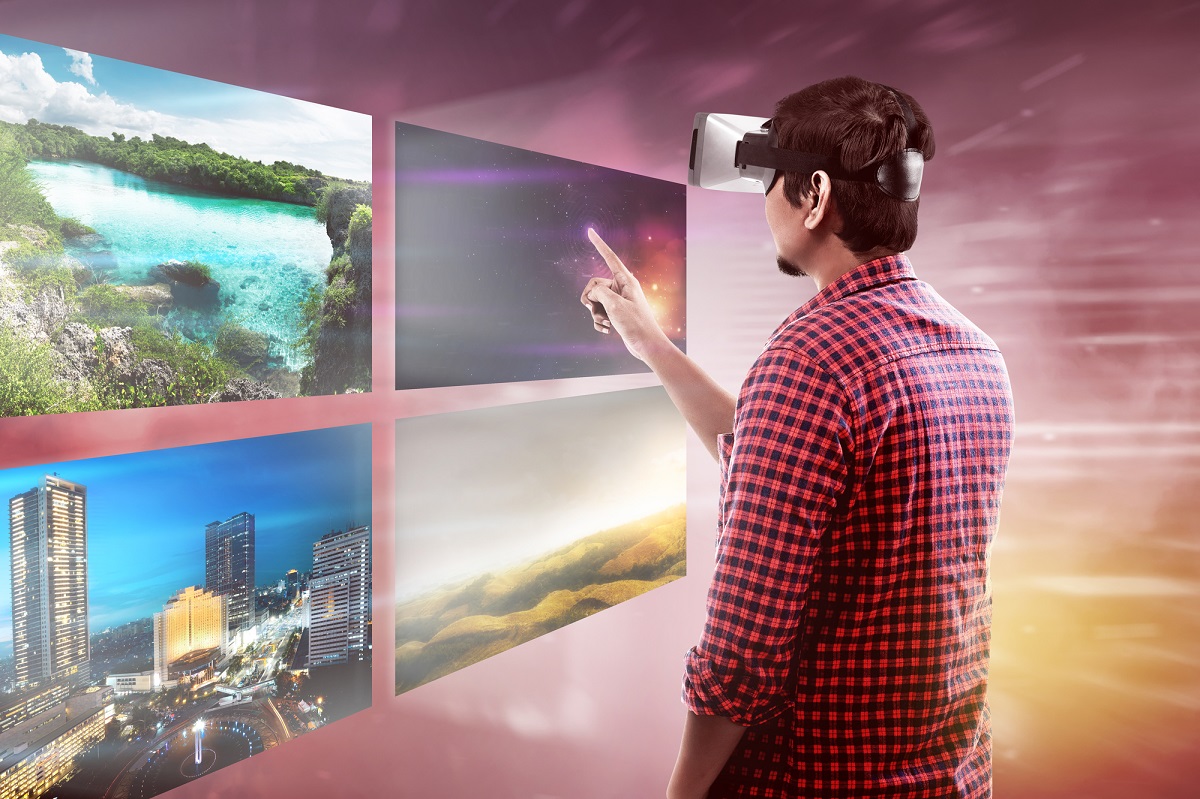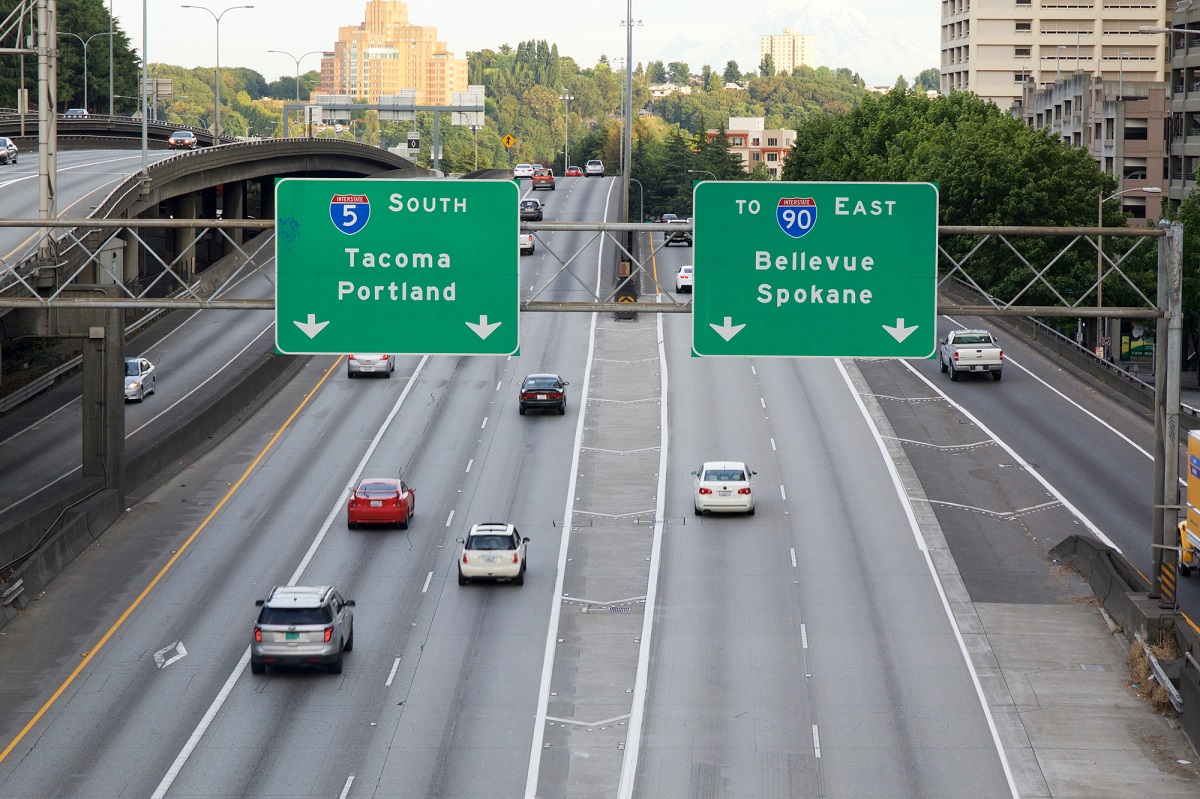Beginning in summer and lasting well into fall is the salmon spawning season in the Seattle-Tacoma metro area. Many people enjoy watching wild salmon as they swim upriver or navigate fish ladders to lay their eggs. There are also spring salmon runs, when young salmon migrate downstream to their life at sea.
The spring salmon runs are less dramatic than those in fall. But there is another spawning fish to observe in spring–the giant peamouth minnow.
When and where to see the peamouth minnow spawn
Unrelated to salmon, peamouth minnows (Mylocheilus caurinus) are a species of freshwater ray-finned fish from the family Cyprinidae (carps and minnows) found in Western North America. The name minnow is a bit misleading. Most of us think of small minnow about 1-1/2 inches long. But the peamouth average one foot in length.
Unlike salmon that spawn (lay eggs) mid-summer to late fall, peamouth spawn earlier, from late April through June. However, the peamouth spawning period is quite short, from 12-48 hours. If you want to see this spectacle, you have to be in the right place at just the right time.
The two best spots to watch the peamouth are in Bellevue at Kelsey Creek under the Wilburton Trestle, and at the Mercer Slough Fish Ladder. Be sure to watch quietly at these sites. In addition to the peamouth, you may see other wildlife looking for dinner, including blue heron, wood ducks, river otters, and bald eagles.
When peamouth are spawning, Kelsey Creek is plastered with gazillions of sticky little eggs that take only a week to hatch. After they have spawned, peamouth head back to Lake Washington. Their average life span is eight years.
- Peamouth are typically observed one to four times from late April through June. They are only around for 12-48 hours, so if you want to see them you have to be there at the right time. More info: Peamouth Minnows | City of Bellevue (bellevuewa.gov)
- Can’t make the trek to Kelsey Creek? Then watch for spawning peamouth as well as other wildlife on the Kelsey Creek Camera. You might also see people on the upstream viewing platforms or scientists doing research in the area. Live camera link: Kelsey Creek Camera | City of Bellevue (bellevuewa.gov)
About Washington State Salmonids
Five species of Pacific salmon are commonly found in Washington State: 1) Chinook or “King”, 2) Coho or “silver”, 3) sockeye or “red”, 4) pink or “humpback”, and 5) chum or “dog salmon”. Other members of the Salmonidae family (“salmonids”) in Washington State include cutthroat trout, steelhead trout, bull trout, Dolly Varden trout, American shad, White sturgeon, and Pacific smelt (also called Columbia River smelt or eulachon).
Note that several types of salmon in the rivers across Washington State are Threatened under the Endangered Species Act, including Chinook, Coho, and sockeye. Therefore, exercise care when you are viewing salmon habitats in the wild.
Likewise, if you plan to do any recreational fishing, be sure to check and follow Washington State recreational fishing regulations.
Listed below are many areas where you can watch salmon spawning. You will also find information about the salmon lifecycle and things to know about protecting natural salmon habitats.
About the salmon lifecycle
Salmon are anadromous fish. This means they are born in fresh water but spend much of their life at sea. Besides salmon, other examples of anadromous fish include sturgeon, shad, smelt, char, and some species of trout.
At the end of their life, salmon migrate back upriver to the place where they were borne. It’s a long and arduous journey. Once they have returned, they lay eggs (known as spawning). Between eggs hatching and returning to spawn, anadromous fish must survive many hazards. Less than one egg in 1,000 survives to adulthood.
After spawning, most (but not all) anadromous species die. During spawning season, you will find salmon carcasses strewn along the riverbank. Their remains are an important part of the ecosystem, providing nutrients for soils along the stream.
Read below for more information about the salmon spawning season in Washington State, especially locations near Seattle and nearby rivers around the Puget Sound region. We’ve included a few locations on the Olympic Peninsula for those that want to make the trek.
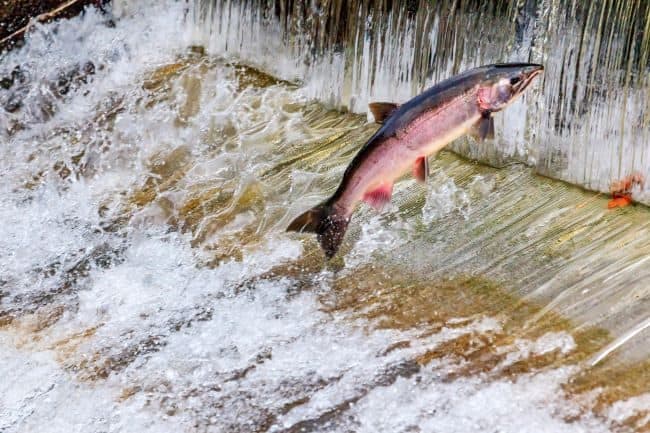
Spawning salmon jumps the fish ladder at Issaquah Hatchery – DepositPhotos.com
Things to know about salmon spawning
When you watch salmon spawn outdoors in creeks and streams, be mindful of the salmon lifecycle and ways you can destroy salmon habitat. If you enjoy fly fishing in fall, be sure to watch for spawning beds.
- In the oceans and rivers, salmon are silver in color. As they move upriver to the spawning beds, salmon will appear red in color.
- Salmon and trout spawn in “redds”, which are depressions in the river bottom created by the fish beating the area with their tail to remove debris and create a suitable place to deposit their eggs.
- After depositing some eggs, they move upstream and again beat the river bottom to create another redd and simultaneously cover the previous egg deposit with gravel. Pretty cool, huh!
- Redds should be easy to spot. In contrast to a normal stream bed, the redd area will be clean with exposed gravel. Some salmon species spawn in large redds that measure 10-feet, which are very obvious.
- Do not walk on spawning beds or directly upriver of the redd. Fish eggs are easily damaged—50% of the eggs can be destroyed by one step, which decay and threaten any remaining eggs.
- Do not disturb or “clean up” dead salmon you see along the riverbank. They are a very important part of the natural ecosystem and provide nutrients for soils along the stream.
In short, take extreme care not to disturb these precious natural habitats. They’ve been doing this for thousands of years and we all want them to continue.
Ballard Locks Fish Ladder in Seattle
Hiram M. Chittenden Locks (aka “Ballard Locks”) is a very accessible location in the city where you can see many salmon migrating to their spawning beds. The locks were built by the U.S. Army Corps of Engineers over 100 years ago. The entire complex includes two boat locks, a spillway to assist in water-level control, and an integrated fish ladder for migration of anadromous fish, notably the salmon that migrate between Lake Washington and Puget Sound.
Chittenden Locks has been the focus of studies about salmon habitat and behavior. Several tribal organizations, along with state and federal agencies have worked together to recommend spillway improvements. In 1976, the Corps renovated and improved the ladder to improve fish conservation. Today’s ladder has 21 steps or weirs, which allow the fish to swim upstream on a gradual incline.
- The locks are open to vessel traffic 24 hours a day and seven days a week.
- The grounds are open to visitors from 7 a.m. to 9 p.m.
- Fish ladder viewing room hours are 7 a.m. to 8:45 p.m.
- Visitor center hours: May-September: 10 a.m. to 6 p.m. open daily. October-April: 10 a.m. to 4 p.m. Thursday-Monday, closed Tuesdays and Wednesdays.
More info: Seattle Chittenden Locks | US Army Corps of Engineers (army.mil)
When to see salmon at the Ballard fish ladder
The Ballard Locks grounds are open to the public from 7 a.m. to 9 p.m. The Fish Ladder Viewing Room Hours are 7 a.m. to 8:45 p.m.
June-November, Salmon migrate at the Ballard Locks fish ladder, peaking in mid-summer. Here are the best salmon viewing times:
- June through October: Sockeye, or Red Salmon (best viewing July)
- July through November: Chinook, or King Salmon (best viewing last two weeks of August)
- August through November: Coho, or Silver Salmon (best viewing last two weeks of September)
More info: Ballard Locks fish ladder
Where to see salmon spawning in Seattle Parks
These following locations are popular places to see salmon spawning in Seattle creeks and streams. See also our calendar event list below.
West Seattle – Longfellow Creek
Roxhill Park in West Seattle is the site of four-mile Longfellow Creek. The stream begins underground and flows north through Delridge Valley, eventually spilling into the Duwamish River.
Start at Dragonfly Garden (on the corner of 28th Avenue SW and SW Dakota St) and walk the creekside trail southward. Look for salmon under bridges where fish often hide.
The five-acre park also features a skate park, playground, a picnic and BBQ area, soccer fields, baseball courts, and a natural wetland.
- October through December watch for Coho and in November watch for chum as they migrate up the creek.
Seattle – Piper’s Creek
Piper’s Creek Natural Area in north Seattle’s Carkeek Park. The Piper’s Creek trailhead is unassuming, sitting between a house and a cyclone fence. As you follow this trail down the hillside, the sound of trickling water hits your ears before the creek comes into view. Follow the trail down to large lawn areas that are part of Carkeek Park and continue past them to find sweeping views of Puget Sound.
- November and December, you can see hundreds of Coho and chum returning to spawn at Piper’s Creek.
- On weekends during the return, volunteer Salmon Stewards will be on hand to explain the salmon’s life cycle and habitat, and the human influence on their survival.
Where to see wild salmon in Carnation – Snoqualmie Valley
Mid-September through October, see returning adult salmon in and around the town of Carnation at three locations:
- Chinook Bend Natural Area map. See salmon from the public access trail, shown as a hot pink line on the map. To access the area, find the parking lot in the vicinity of 30900 NE Carnation Farm Road.
- Tolt MacDonald Park map. See salmon from the footbridge over the Snoqualmie River shown as a red line on the park map. The park boasts a campground and miles of forested and riverside trails. In the opposite direction, you can venture onto the Snoqualmie Valley Trail.
- Snoqualmie Valley Trail map. See salmon from the footbridge over the Tolt River, near markers 9 and 10 on the map. It spans about 30 miles, from Duvall in the north, south past North Bend to Rattlesnake Lake. The gravel trail is a mostly flat but is not recommended for regular bikes or wheelchairs.
Other Puget Sound salmon viewing locations
Salmon habitat is an essential part of an overall efforts to restore Puget Sound water quality, severely contaminated by decades of industrial and urban growth. Recovery efforts include hatchery and harvesting to restore Chinook salmon populations in rivers, creeks, and streams around the county. Read about the King county Salmon Watcher Program, including tips for helping our salmon populations thrive.
Listed below are places are great places to see some action during the fall salmon spawning season. They are listed alphabetically by city. For a list of upcoming salmon, scroll down for a calendar list.
Bothell – North Creek
North Creek Park in Bothell. Walk the paved trail north along the creek, cross 195th Street, and continue through the North Creek Business Park. Look for salmon under bridges where fish often hide. Here’s what to watch for and when:
- September: Chinook
- October: sockeye
- November: coho
Issaquah Hatchery
The Issaquah hatchery located 15 miles east of Seattle is the most visited hatchery managed by the Washington Department of Fish and Wildlife. The hatchery grounds are open year-round during daylight hours. The hatchery grounds feature “salmon-friendly” native plant gardens, wetlands, and fishponds. Indoor exhibits are open daily from 8:00AM to 4:00PM, where visitors can learn about the salmon life-cycle through displays and interactive exhibits. Depending on when you visit, you can see salmon in various stages. Here’s a seasonal guideline:
- Fall is the most active time of year. The hatchery is outdoors, open from dawn til dusk and free to the general public. During the fall spawning season, a fish ladder gets visitors a close-up view of returning salmon. The hatchery also raises rainbow trout, which are usually on display in the fall. The fall salmon runs begin in late August when hundreds of salmon begin returning to spawn. Usually Chinook (king) arrive first and Coho (silver) a little later. Visitors can tour the educational center, view the fish ladder and smolt aquarium room, see adult salmon, and interact with educational displays. There is also a small keepsake salmon gift store on site. Mid-September to mid-November is peak season for salmon runs at the Issaquah hatchery. Best viewing hours are weekends 10am to 5pm.
- Winter to spring, eggs laid in the fall will hatch in the incubation room and small salmon are moved to outside ponds for feeding before their release. Winter through spring is a good time to visit the indoor exhibits and educate yourself about salmon habitat.
- Spring to summer, young Coho and Chinook old enough to migrate to salt water are released into Issaquah Creek. Rainbow trout are also released into several nearby lakes.
- During summer, juvenile fish too young to migrate are kept in ponds and fed until they can be released next spring. Rainbow trout are usually on display in the glassed-in holding ponds. Summer is also a great time to visit the hatchery’s gardens and outdoor displays. Summertime Salmon Science Camps are engaging, fun programs for preschoolers and school-age children.
Redmond – Sammamish River
Sammamish River Trail is a 10-mile paved pathway and one of the King County’s most popular regional trails. September and October, you may be able to see adult Chinook, Coho, and sockeye salmon as they migrate up the river to their spawning grounds in Bear Creek.
Renton – Cedar River
The Cedar River Salmon Journey, hosted by the Seattle Aquarium takes place at salmon spawning beds along the Cedar River. You might see Chinook, Coho, and sockeye salmon. Weekends in October, see spawning salmon at any of the following locations throughout the Renton and Maple Valleys:
- Jones Park, 98 Wells Ave S, Renton, WA 98058
- Renton Library, 100 Mill Ave. South, Renton WA 98057
- Cedar River Park, 1717 Maple Valley Hwy., Renton WA 98057
- Riverview Park, 3201 Maple Valley Hwy., Renton WA 98058
- Belmondo Reach Natural Area, 16248 SE Cedar Mountain Place, Renton, WA, 98058
- Landsburg Park and Dam, SE 252nd Pl. & Landsburg Rd. SE, Ravensdale, WA 98051
Sammamish Kokanee “little red salmon”
Kokanee are one of the few native salmon populations in Washington State. These “little red salmon” are smaller versions of the sockeye. Unlike anadromous salmon that migrate to the ocean and back to fresh water to spawn, kokanee spend their entire life in freshwater.
From early November to late January you might see kokanee salmon spawning runs in a handful of streams that flow into Lake Sammamish–see the list of locations below.
- Ebright Creek at the East Lake Sammamish Trail in Sammamish
- Lewis Creek at 185th Place SE in Issaquah
- Laughing Jacobs Creek near Lake Sammamish State Park
- For more information, visit: https://www.govlink.org/watersheds/8/action/salmon-seeson/ebright-lewis.aspx
Tukwila – Duwamish River
The Duwamish River system begins in the forests of Mount Rainier and travels through agricultural, residential, and industrial areas. The river collects water from the Green River and storm drains in the cities and towns through which it passes before becoming the Duwamish River and spilling into the south end of Seattle’s Elliot Bay.
Due to a century of industrial and urban activity along the river, the Duwamish became heavily polluted. In 2001, it was designated a Superfund Site by the U.S. Environmental Protection Agency (EPA)—one of the country’s most toxic hazardous waste sites.
Since then, many local groups, governments, and federal agencies have worked to develop and implement a cleanup plan that will reduce the levels of dangerous toxins and restore the health of the water. The Duwamish River Cleanup Plan is expected to take at least until the year 2037 to achieve an effective cleanup.
In spring, salmon in their juvenile stage rest in the inlets on both sides of the Duwamish River during their journey to Puget Sound and a life at sea.
September-January, adult salmon can be seen returning to the river to spawn through fall and into winter. There are several good salmon viewing spots along the Duwamish River:
- Codiga Park, 50th Place South, Tukwila, WA 98178. See Chinook, pink, Coho, chum, and steelhead salmon migrate up the river. The park sits on the site of a former dairy farm owned by the Codiga family.
- North Wind’s Weir, 2914 South 112th St. Tukwila, WA 98168. See Chinook, pink, Coho, chum, and steelhead migrate upstream spawning beds through the natural weir. View the river from the wheelchair-accessible walking bridge or the flat walking trail around the perimeter of the restored habitat site.
- Duwamish Gardens Park, 11269 East Marginal Way S, Tukwila, WA Tukwila’s newest park a short distance from Duwamish Hill Preserve was the former Ray-Carrossino Dairy Farm. The park provides critical shallow water habitat essential to the survival of juvenile salmon.
Olympic Peninsula Salmon Viewing locations
Late September to early November (peak season usually during October) you can see salmon and other anadromous species spawning in several rivers on the Olympic Peninsula. Here are a few suggested locations for spelunking on your own:
- Railroad Bridge Park is two miles west of the town of Sequim. The park is on the Olympic Discovery Trail, a former railway that extends from Port Townsend on the northeastern tip of the Washington peninsula all the way to the shores of the Pacific Ocean. A nice side trip includes the Dungeness River Audubon Center.
- Sol Duc Valley is one of the best places to see salmon migrating upstream. Sol Duc Hot Springs Resort offers lodging, an RV campground, and tent campsites.
- Salmon Cascades Overlook (nps.gov). Most rivers in Olympic National Park host a fall salmon run, but the Salmon Cascades Overlook in the Sol Duc Valley provides one of the best views from late September to Early October. Olympic’s rivers are home to all five species of Pacific salmon, as well as anadromous steelhead and bull trout.
- Quinault Rain Forest Loop is an easy trail with lush green trees, Quinault river, and Willaby Creek Falls. You may or may not see salmon.
Event calendar of free and affordable things to do
Listed below are all types of free and affordable things to do in the next 30 days.
Featured Events are listed first each day, highlighted by a photo. These are unique, popular, or annual events that we or our advertisers don’t want you to overlook.
Find more events and ideas for affordable living at Greater Seattle on the Cheap – Free things to do, cheap fun, discounts and deals in the Seattle-Tacoma metro area


